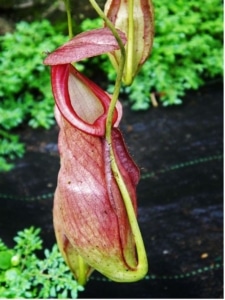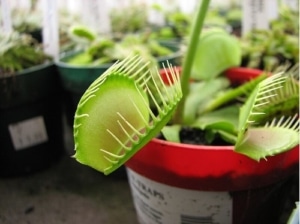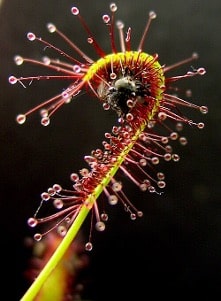DCPA NEWS CENTER
Enjoy the best stories and perspectives from the theatre world today.
Enjoy the best stories and perspectives from the theatre world today.
You won’t hear “feed me Seymour” at any of these plant shops, but that doesn’t mean the residents don’t bite. Luckily the Venus flytrap, monkey cup, and cobra lily have more interest in consuming bugs than they do people.
As Denver embraces the stage production of Little Shop of Horrors, running now until May 25 at the Wolf Theatre, we have these special plants on our mind. Discover the nuances, learn about the types, then go out and claim your own. Keeping one (or 10) isn’t difficult or dangerous at all.
GET TO KNOW CARNIVOROUS PLANTS

Nepenthes pitcher plant
Before diving into the wonderful world of carnivorous plants, or insectivorous plants, decide which of the four types speak to you. Each one falls under the category of either pitcher plants, sundews, bladderworts, and butterworts.
Many pitcher plants look a lot like their namesake, though the deadly cups come in many bulbous shapes. Each fill with a liquid consisting of digestive enzymes and rain, which lures the insects, small frogs, and crabs inside. The flap on top prevents the creatures from crawling out, allowing the plant to “eat” them.
Sundews are another recognizable plant, with 194 known species in the category. The thin, finger like leaves have delicate mucilaginous glands covering them, which the plant uses to capture and digest insects. The name comes from how the plant glitters in the sun, giving off a jewel-like aura thanks to those wicked, yet beautiful, glands. The famous Venus flytrap, the inspiration for Little Shop of Horrors, is one of them.
While the name bladderwort sounds like a joke your 10-year-old kid would make, it actually comes from the small, hollow sacs embedded around the stem. These pouches capture and digest insect larvae, aquatic worms, and water fleas. There are more than 200 species, and they live in fresh water and wet soil all over the world.
When seeing a butterwort for the first time, it may surprise you to learn it’s in the carnivorous plant category. It looks a lot like a succulent with bright green, stalkless leaves. But the only thing succulent about the plant is the buttery, oily leaves that lure and capture gnats and fruit flies.
WHERE TO FIND CARNIVOROUS PLANTS IN DENVER

Venus Flytrap
Stalk Market Co. in Edgewater Public Market
5505 W. 20th Ave., Edgewater
Inside the market and food hall there’s a little plant shop that gets in Venus flytraps every Thursday. They tend to sell out fast, so it’s best to go before the weekend rush. The plants aren’t expensive either, so try your luck with two and start building your own Audrey II army.
The Plant Room
1937 Federal Blvd., Denver
Enter this intimate jungle of a plant shop and find some lovely Nepenthes, Droseraceae, and other wicked plants waiting for a forever home. From time to time, you’ll find a curated bowl of aquatic and water-loving carnivorous plants too. Overall, the independent shop is worth a trip just to bask in the beauty and peaceful shades of green.

Sundew
Echter’s Nursery & Garden Center
5150 Garrison St., Arvada
One of the state’s largest garden shops is located in Arvada, and it has also been one of the best since 1952. While customers can peruse plenty of flowers, trees, herbs, bushes, vegetable seedlings, and more, it’s the small carnivorous plant section we really love. Find this curated display in the tropical plant area, and if you have ques,tions the knowledgeable staff is on hand to help.
Nick’s Garden Center and Farm Market
2001 S. Chambers Rd.
For over 30 years the family-owned and operated plant shop has served Aurora with all the residents’ planting needs, both inside and out. Here you’ll find everything you need to start a carnivorous plant garden. That includes terrariums, globe planters, moss, spray bottles, and of course, the plants too.
Denver Botanic Gardens
1007 York St., Denver
If you only want to see carnivorous plants, the Denver Botanic Gardens’ York Street location is the place to go. These gorgeous specimens are located in the orangery, part of the indoor space on the north side of the venue. Here you’ll find Venus flytraps and other sundews, terrestrial and aquatic bladderworts, and more. Best part, you can visit all year round.
